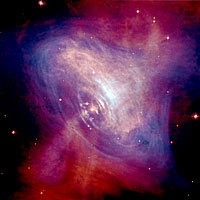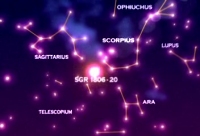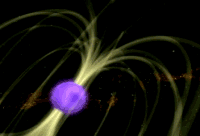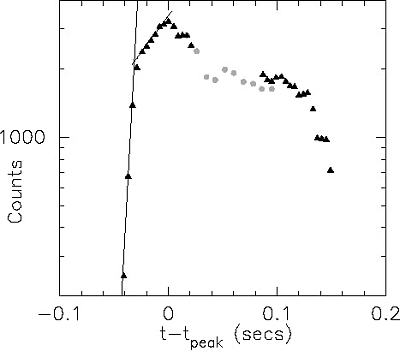Double Star and Cluster observe first evidence of crustal cracking
21 September 2005
On 27 December 2004, radiation from the biggest starquake on a neutron star ever recorded reached Earth. Unique data obtained by Double Star TC-2 and Cluster satellites enabled a group of European scientists to find the first observational evidence of cracks in the neutron star crust, during the initial phase of the starquake. This result, published 16 June 2005 in the Astrophysical Journal, dicriminates between current theories on the physical origin of such massive starquakes.
Neutron stars, pulsars and magnetars
Millions of neutron stars populate our Milky Way galaxy. A neutron star is the remaining core of a massive star, once it has exploded. Made almost entirely of neutrons (subatomic particles with no electric charge), this stellar corpse concentrates more than the mass of our Sun within a sphere of ~20 km diameter. It is so dense that a sugar cube of neutron star on Earth would weight as much as all of humanity!
Two other physical properties characterise a neutron star, their fast rotation (or spin) and their high magnetic field. Astronomers have found different classes of neutron stars based on these properties. Some of them are the fastest spinning stars in the Universe (up to hundreds of revolutions per second); named pulsars (Image 1), as they generate regular pulses of electromagnetic radiation including radio, visible, X-ray and gamma-ray wavelengths. These pulses are often compared to a spinning lighthouse beacon which appears to flash on and off.
 |
 |
|
Image 1. The Crab pulsar in a composite view from Hubble (optical in blue) and Chandra (X-ray in red). Credit: NASA/HST/ASU/J. Hester et al., NASA/CXC/ASU/J. Hester et al. |
Image 2. Artistic impression of cracks on a magnetar in the initial phase of a starquake. Credit: NASA. |
Another class of neutron stars is known as magnetars (Image 2), due to their ultra-high magnetic field. Their magnetic field intensity is indeed about 100 gigaTesla (or 1011 T), a thousand times more than an ordinary neutron star. By comparison, the Earth's magnetic field is about 50 microTesla (5×10-5 T). Most media used for data storage can be erased if they are exposed to a magnetic field of milliTesla (10-3 T) intensity.
So far, a dozen of magnetars have been found. Four of them are also known as soft gamma repeaters, or SGRs, because they sporadically release large bursts of low energy (soft) gamma rays and (hard) X-rays, usually during short time periods (~ 0.1 s).
Extreme starquake on 27 December 2004
 |
|
Image 3. SGR 1806-20 location. Credit: NASA. |
On 27 December 2004, the radiation from an extremely powerful explosion on the surface of SGR 1806-20 (the numbers indicate its position in the sky) reached Earth and lasted more than 6 minutes. During the first 200 ms, the amount of energy released was equivalent to what our Sun radiates in 250 000 years. It is the brightest event known to have impacted the Earth from an origin outside our solar system.
SGR 1806-20 is located at around 50 000 light-years from Earth on the far side of our Milky Way galaxy, in the direction of the Sagittarius constellation (Image 3). A similar blast within 10 light years would have destroyed the ozone layer and be similar to a major nuclear blast. Fortunately, the closest known magnetar is 13 000 light years away.
Missing link found by Double Star and Cluster
 |
|
Video 1. Artist's impression of a giant flare from a magnetar after the cracking of its surface. |
Although designed to study the Earth's magnetosphere, the thermal electron detectors onboard Double star TC-2 and Cluster satellites performed unsaturated observations of this initial flare rise and decay (Image 4). As explained in his 16 June paper, Professor Schwartz and his co-authors show that these unique data provide the first observational evidence of three separate timescales within the first 100 ms of this event. The characteristics of these timescales (such as the number, duration, shape) play an important role in actual theories of starquakes on magnetars, which allows discriminating between them.
Based on these measured timescales and current theoretical models, the following scenario is confirmed in this paper. The giant flare is produced when the crust of the magnetar can no longer respond almost plastically to internal magnetic stress and finally cracks. One of the three timescales even allows an estimation of the fracture size: about 5 km. This is a significant size considering that SGR 1806-20 has been estimated to be a sphere of few tens of km in diameter.
 |
|
Image 4. Combined Double Star TC-2 (triangles) and Cluster 4 High Energy Electron Analyser (gray circles) count rates. The data have been shifted in time to align features near the peak count rates. Solid lines show exponential fits to the steepest TC-2 rise, and also to the TC-2 determination of the period leading to the main peak [Schwartz et al., 2005]. |
On 27 June 2005, the Astrophysical Journal published a related study on SGR 1806-20, this time led by Italian astronomer GianLuca Israel from INAF-Osservatorio Astronomico di Roma. His data analysis reveals the presence of quasi-periodic oscillations (or modes) at the end of the 27 December 2004 event.
"These modes are likely to be associated with global seismic oscillations. In particular, the large crustal fracturing inferred by us can easily excite toroidal modes with characteristic frequencies in the observed range", commented Professor Schwartz in his 16 June paper.
Therefore, Double Star TC-2 and Cluster data have not only enabled to directly estimate crustal properties of magnetars, they have also linked interior magnetic processes and their external consequences during giant flares.
"Cluster and Double Star were designed to study the various boundary layers of the Earth's magnetosphere, including the physics of magnetic reconnection. Such boundary layer physics has application throughout the astrophysical plasma universe, and it is therefore appropriate that these missions contribute in a more direct way to the study of magnetic reorganisation in an astrophysical object outside the solar system", concluded Professor Schwartz.
This new result illustrates the complementarity of the Double Star and the Cluster missions. New results from both missions will be discussed this week (19-23 September) at ESTEC during a five day symposium gathering more than 200 researchers coming from Europe, USA, China and Japan.
Schwartz, S.J., Zane, S., Wilson, R.J., Pijpers, F.P., Moore, D.R., Kataria, D., Horbury, T.S., Fazakerley, A.N., Cargill, P.J., A γ-ray giant flare from SGR1806-20: evidence for crustal cracking via initial timescales, ApJ, 627:L129–L132, 2005.
Related articles
K. Hurley, S. E. Boggs, D. M. Smith, R. C. Duncan, R. Lin, A. Zoglauer, S. Krucker, G. Hurford, H. Hudson, C. Wigger, W. Hajdas, C. Thompson, I. Mitrofanov, A. Sanin, W. Boynton, C. Fellows, A. von Kienlin, G. Lichti, A. Rau, T. Cline, An exceptionally bright flare from SGR 1806–20 and the origins of short-duration γ-ray bursts, Nature 434, 1098-1103 (28 April 2005), doi: 10.1038/nature03519
Israel, G. L., T. Belloni, L. Stella, Y. Rephaeli, D. E. Gruber, P. Casella, S. Dall'Osso, N. Rea, Discovery of rapid X-ray oscillations in the tail of the SGR 1806-20 hyperflare, ApJ, 628:L53–L56, 2005
Michael Schirber, The biggest starquake ever, Space.com, 18 July 2005.
http://space.com/scienceastronomy/050718_star_quake.html
Contact
Steve Schwartz, Space and Atmospheric Physics Group, Blackett Laboratory, Imperial College, United Kingdom
Tel: +44-(0)20-7594-7660
Email address: s.schwartz imperial.ac.uk
imperial.ac.uk
Web story author
Arnaud Masson, SCI-SH division, RSSD, ESA, The Netherlands.
Telephone: +31-71-565-5634
Web story editor
Philippe Escoubet, SCI-SH division RSSD, ESA, The Netherlands.
Telephone: +31-71-565-3454
